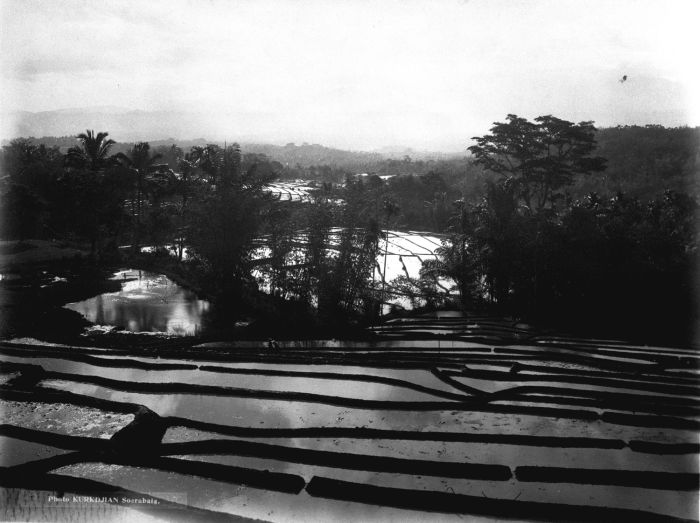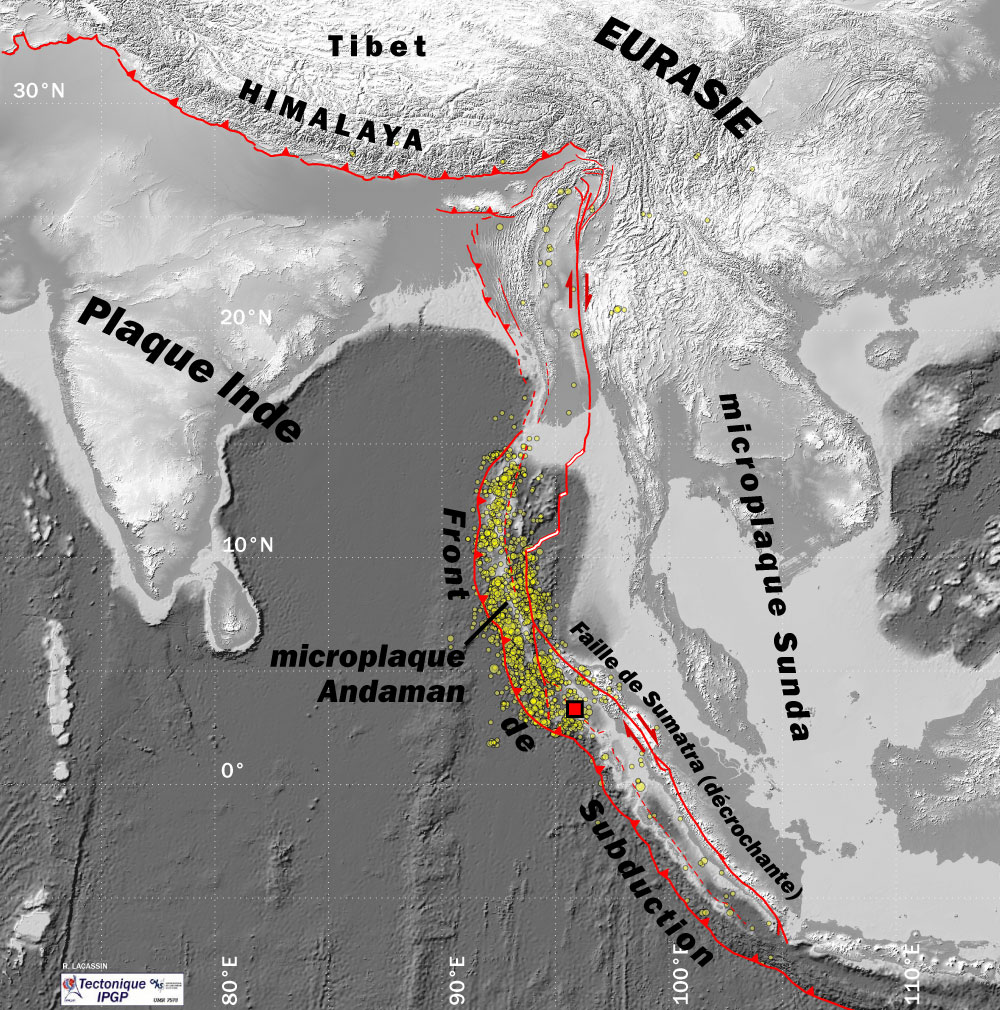|
Lembang Fault
The Lembang Fault (Indonesian: Sesar Lembang) is an active fault located 10 km north of the city of Bandung on the Indonesian island of Java. This sinistral slip fault is estimated to measure 29 km in length. While no historical earthquakes have occurred, the fault is thought to be possible of generating a magnitude () 6.5 to 7.0 earthquake in the future. Because of the potential for large and damaging earthquakes on the fault, the Meteorology, Climatology and Geophysics Agency (BMKG) has been monitoring activity on the fault. Activity Paleoseismic trenching along the fault in a 2019 study uncovered three earthquakes in the 15th century, 2300–60 BCE and 19,620–19,140 BP with a recurrence interval of 170 to 670 years. Threat The Indonesian Institute of Sciences The Indonesian Institute of Sciences ( id, Lembaga Ilmu Pengetahuan Indonesia, or LIPI) was the governmental authority for science and research in Indonesia. It consists of 47 research centers in the fields ra ... [...More Info...] [...Related Items...] OR: [Wikipedia] [Google] [Baidu] |
Indonesia
Indonesia, officially the Republic of Indonesia, is a country in Southeast Asia and Oceania between the Indian and Pacific oceans. It consists of over 17,000 islands, including Sumatra, Java, Sulawesi, and parts of Borneo and New Guinea. Indonesia is the world's largest archipelagic state and the 14th-largest country by area, at . With over 275 million people, Indonesia is the world's fourth-most populous country and the most populous Muslim-majority country. Java, the world's most populous island, is home to more than half of the country's population. Indonesia is a presidential republic with an elected legislature. It has 38 provinces, of which nine have special status. The country's capital, Jakarta, is the world's second-most populous urban area. Indonesia shares land borders with Papua New Guinea, East Timor, and the East Malaysia, eastern part of Malaysia, as well as maritime borders with Singapore, Vietnam, Thailand, the Philippines, Australia, Palau, an ... [...More Info...] [...Related Items...] OR: [Wikipedia] [Google] [Baidu] |
Bandung
Bandung ( su, ᮘᮔ᮪ᮓᮥᮀ, Bandung, ; ) is the capital city of the Indonesian province of West Java. It has a population of 2,452,943 within its city limits according to the official estimates as at mid 2021, making it the fourth most populous city in Indonesia. Greater Bandung (Bandung Basin Metropolitan Area/BBMA) is the country's third-largest metropolitan area, with nearly nine million inhabitants. Located above sea level, the highest point in the North area with an altitude of 1,050 meters and the lowest in the South is 675 meters above sea level, approximately southeast of Jakarta, Bandung has cooler year-round temperatures than most other Indonesian cities. The city lies on a river basin surrounded by volcanic mountains that provides a natural defence system, which was the primary reason for the Dutch East Indies government's plan to move the capital from Batavia (modern-day Jakarta) to Bandung. The Dutch first established tea plantations around the moun ... [...More Info...] [...Related Items...] OR: [Wikipedia] [Google] [Baidu] |
West Java
West Java ( id, Jawa Barat, su, ᮏᮝ ᮊᮥᮜᮧᮔ᮪, romanized ''Jawa Kulon'') is a province of Indonesia on the western part of the island of Java, with its provincial capital in Bandung. West Java is bordered by the province of Banten and the country's capital region of Jakarta to the west, the Java Sea to the north, the province of Central Java to the east and the Indian Ocean to the south. With Banten, this province is the native homeland of the Sundanese people, the second-largest ethnic group in Indonesia. West Java was one of the first eight provinces of Indonesia formed following the country's independence proclamation and was later legally re-established on 14 July 1950. In 1966, the city of Jakarta was split off from West Java as a 'special capital region' (), with a status equivalent to that of a province, while in 2000 the western parts of the province were in turn split away to form a separate Banten province. Even following these split-offs, West J ... [...More Info...] [...Related Items...] OR: [Wikipedia] [Google] [Baidu] |
Pleistocene
The Pleistocene ( , often referred to as the '' Ice age'') is the geological epoch that lasted from about 2,580,000 to 11,700 years ago, spanning the Earth's most recent period of repeated glaciations. Before a change was finally confirmed in 2009 by the International Union of Geological Sciences, the cutoff of the Pleistocene and the preceding Pliocene was regarded as being 1.806 million years Before Present (BP). Publications from earlier years may use either definition of the period. The end of the Pleistocene corresponds with the end of the last glacial period and also with the end of the Paleolithic age used in archaeology. The name is a combination of Ancient Greek grc, label=none, πλεῖστος, pleīstos, most and grc, label=none, καινός, kainós (latinized as ), 'new'. At the end of the preceding Pliocene, the previously isolated North and South American continents were joined by the Isthmus of Panama, causing a faunal interchange between the t ... [...More Info...] [...Related Items...] OR: [Wikipedia] [Google] [Baidu] |
Fault Scarp
A fault scarp is a small step or offset on the ground surface where one side of a fault has moved vertically with respect to the other. It is the topographic expression of faulting attributed to the displacement of the land surface by movement along faults. They are exhibited either by differential movement and subsequent erosion along an old ''inactive'' geologic fault (a sort of old rupture), or by a movement on a recent active fault. Characteristics Fault scarps often contain highly fractured rock of both hard and weak consistency. In many cases, bluffs form from the upthrown block and can be very steep. The height of the scarp formation is equal to the vertical displacement along the fault. Active scarps are usually formed by tectonic displacement, e.g. when an earthquake changes the elevation of the ground and can be caused by any type of fault, including strike-slip faults, whose motion is primarily horizontal. This movement is usually episodic, with the height of the bluf ... [...More Info...] [...Related Items...] OR: [Wikipedia] [Google] [Baidu] |
Fault (geology)
In geology, a fault is a planar fracture or discontinuity in a volume of rock across which there has been significant displacement as a result of rock-mass movements. Large faults within Earth's crust result from the action of plate tectonic forces, with the largest forming the boundaries between the plates, such as the megathrust faults of subduction zones or transform faults. Energy release associated with rapid movement on active faults is the cause of most earthquakes. Faults may also displace slowly, by aseismic creep. A ''fault plane'' is the plane that represents the fracture surface of a fault. A '' fault trace'' or ''fault line'' is a place where the fault can be seen or mapped on the surface. A fault trace is also the line commonly plotted on geologic maps to represent a fault. A ''fault zone'' is a cluster of parallel faults. However, the term is also used for the zone of crushed rock along a single fault. Prolonged motion along closely spaced faults can bl ... [...More Info...] [...Related Items...] OR: [Wikipedia] [Google] [Baidu] |
Java
Java (; id, Jawa, ; jv, ꦗꦮ; su, ) is one of the Greater Sunda Islands in Indonesia. It is bordered by the Indian Ocean to the south and the Java Sea to the north. With a population of 151.6 million people, Java is the world's most populous island, home to approximately 56% of the Indonesian population. Indonesia's capital city, Jakarta, is on Java's northwestern coast. Many of the best known events in Indonesian history took place on Java. It was the centre of powerful Hindu-Buddhist empires, the Islamic sultanates, and the core of the colonial Dutch East Indies. Java was also the center of the Indonesian struggle for independence during the 1930s and 1940s. Java dominates Indonesia politically, economically and culturally. Four of Indonesia's eight UNESCO world heritage sites are located in Java: Ujung Kulon National Park, Borobudur Temple, Prambanan Temple, and Sangiran Early Man Site. Formed by volcanic eruptions due to geologic subduction of the Aust ... [...More Info...] [...Related Items...] OR: [Wikipedia] [Google] [Baidu] |
Earthquake
An earthquake (also known as a quake, tremor or temblor) is the shaking of the surface of the Earth resulting from a sudden release of energy in the Earth's lithosphere that creates seismic waves. Earthquakes can range in intensity, from those that are so weak that they cannot be felt, to those violent enough to propel objects and people into the air, damage critical infrastructure, and wreak destruction across entire cities. The seismic activity of an area is the frequency, type, and size of earthquakes experienced over a particular time period. The seismicity at a particular location in the Earth is the average rate of seismic energy release per unit volume. The word ''tremor'' is also used for Episodic tremor and slip, non-earthquake seismic rumbling. At the Earth's surface, earthquakes manifest themselves by shaking and displacing or disrupting the ground. When the epicenter of a large earthquake is located offshore, the seabed may be displaced sufficiently to cause ... [...More Info...] [...Related Items...] OR: [Wikipedia] [Google] [Baidu] |
Meteorology, Climatology And Geophysics Agency
Meteorology, Climatology, and Geophysical Agency ( id, Badan Meteorologi, Klimatologi, dan Geofisika, abbreviated BMKG) is an Indonesian non-departmental government agency for meteorology, climatology, and geophysics. History Its history began on 1841 with individual observation conducted by Dr. Onnen, the head of hospital in Bogor, and was established as a formal government institution on 1866 by the Dutch East Indies government by the name of ''Magnetisch en Meteorologisch Observatorium''. The agency name changed several times and its current name was given on 6 September 2008. Tropical Cyclone Warning Centre Since 1986 the BMKG, has run a Tropical Cyclone Warning Centre (TCWC), within their headquarters in Jakarta. Over the next 12 ...[...More Info...] [...Related Items...] OR: [Wikipedia] [Google] [Baidu] |
Indonesian Institute Of Sciences
The Indonesian Institute of Sciences ( id, Lembaga Ilmu Pengetahuan Indonesia, or LIPI) was the governmental authority for science and research in Indonesia. It consists of 47 research centers in the fields ranging from social to natural sciences. With the enactment of Presidential Decree No. 33/2021 on 5 May 2021, LIPI was disbanded along with government research agencies such as Agency of Assessment and Application of Technology (Indonesian: '' Badan Pengkajian dan Penerapan Teknologi'', BPPT), National Nuclear Energy Agency (Indonesian: '' Badan Tenaga Nuklir Nasional'', BATAN), and National Institute of Aeronautics and Space (Indonesian: ''Lembaga Penerbangan dan Antariksa Nasional'', LAPAN). All of those agencies fused into the newly formed National Research and Innovation Agency (Indonesian: ''Badan Riset dan Inovasi Nasional'', BRIN). Currently the disbandment process is still on process and expected to be finished on 1 January 2022. On 1 September 2021, LIPI finally ... [...More Info...] [...Related Items...] OR: [Wikipedia] [Google] [Baidu] |
The Jakarta Post
''The Jakarta Post'' is a daily English-language newspaper in Indonesia. The paper is owned by PT Niskala Media Tenggara and based in the nation's capital, Jakarta. ''The Jakarta Post'' started as a collaboration between four Indonesian media at the urging of Information Minister Ali Murtopo and politician Jusuf Wanandi. After the first issue was printed on 25 April 1983, it spent several years with minimal advertisements and increasing circulation. After a change in chief editors in 1991, it began to take a more vocal pro-democracy point of view. The paper was one of the few Indonesian English-language dailies to survive the 1997 Asian financial crisis and currently has a circulation of about 40,000. ''The Jakarta Post'' also features an online edition and a weekend magazine supplement called J+. The newspaper is targeted at foreigners and educated Indonesians, although the middle-class Indonesian readership has increased. Noted for being a training ground for local and ... [...More Info...] [...Related Items...] OR: [Wikipedia] [Google] [Baidu] |
2004 Indian Ocean Earthquake And Tsunami
An earthquake and a tsunami, known as the Boxing Day Tsunami and, by the scientific community, the Sumatra–Andaman earthquake, occurred at 07:58:53 local time (UTC+07:00, UTC+7) on 26 December 2004, with an epicentre off the west coast of northern Sumatra, Indonesia. It was an Submarine earthquake, undersea megathrust earthquake that registered a magnitude of 9.1–9.3 , reaching a Modified Mercalli intensity scale, Mercalli intensity up to IX in certain areas. The earthquake was caused by a rupture along the fault between the Burma Plate and the Indian Plate. A series of massive tsunami waves grew up to high once heading inland, after being created by the underwater seismic activity offshore. Communities along the surrounding coasts of the Indian Ocean were devastated, and the tsunamis killed an estimated 227,898 people in 14 countries, making it List of natural disasters by death toll#Ten deadliest natural disasters since 1900 excluding epidemics and famines, one of the de ... [...More Info...] [...Related Items...] OR: [Wikipedia] [Google] [Baidu] |





